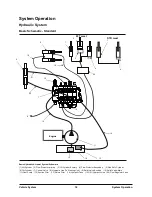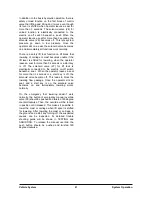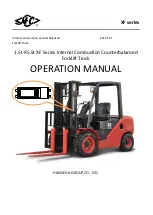
Vehicle System
Testing and Adjusting
32
Testing and Adjusting
Troubleshooting
Troubleshooting can be difficult. A list of possible
problems and corrections are on the pages that
follow.
This list of problems and corrections will only give an
indication of where a problem can be and what
repairs are needed. Normally, more or other repair
work is needed beyond the recommendations on the
list. Remember that a problem is not necessarily
caused only by one part, but by the relation of one
part with other parts. This list can not give all
possible problems and corrections. The serviceman
must find the problem and its source, then make the
necessary repairs.
Tools Needed
Fittings Group
1
The Fitting Group is used to make the pressure tests
of the hydraulic system. Before any test is made,
visually inspect the complete hydraulic system for
leakage of oil and for parts that have damage.
WARNING
To prevent personal injury when testing and
adjusting the hydraulic system, move the
machine to a smooth horizontal location and
lower the mast and carriage to the ground. If the
mast and carriage can not be on the ground,
make sure they are blocked correctly to keep
them from a fall that is not expected. Move away
from machines and personnel that are at work.
There must be only one operator. Keep all other
personnel away from the machine, or where the
operator can see the other personnel.
Before any hydraulic pressure plug, line or
component is removed, make sure all hydraulic
pressure is released.
Visual Checks
A visual inspection of the hydraulic system and its
components is the first step when a diagnosis of a
problem is made. Lower the carriage to the floor and
follow these inspections;
1.
Measure the oil level. Look for air bubbles in the
oil tank..
2.
Remove the filter element and look for particles
removed from the oil by the filter element. A
magnet will separate ferrous particles from
nonferrous particles (piston rings, O-ring seals,
etc.).
3.
Check all oil lines and connections for damage or
leaks.
4.
Check all the lift chains and the mast and carriage
welds for wear or damage.
Performance Tests
The performance tests can be used to find leakage
in the system. They can also be used to find a bad
valve or pump. The speed of rod movement when
the cylinders move can be used to check the
condition of the cylinders and the pump.
Lift, lower, tilt forward and tilt back the forks several
times.
1.
Watch the cylinders as they are extended and
retracted. Movement must be smooth and regular.
2.
Listen for noise from the pump.
3.
Listen for the sound of the relief valve. It must not
open except when the cylinders are fully extended
or retracted without load on forks.
Hydraulic Oil Temperature (Too Hot)
When the temperature of the hydraulic oil gets over
98.8° C (210° F), polyurethane seals in the system
start to fail. High oil temperature causes seal failure
to become more rapid. There are many reasons why
the temperature of the oil will get this hot.
1.
Hydraulic pump is badly worn.
2.
Heavy hydraulic loads that cause the relief valve
to open.
Summary of Contents for D20G
Page 2: ......
Page 5: ...Specifications TORQUE SPECIFICATIONS SB2004E00 D e c 1 9 9 8 ...
Page 14: ......
Page 16: ......
Page 138: ...Diesel Engine Engine System 124 NOTE The crankshaft must rotate freely by hand 02900058 ...
Page 254: ......
Page 256: ......
Page 260: ......
Page 341: ...4TNV98 4TNE98 Diesel Engine Section 3 Engine 87 4TNE98 Engine Figure 6 1 ...
Page 423: ...4TNV98 4TNE98 Diesel Engine Section 4 Fuel System 169 Fuel System Components Figure 7 1 ...
Page 477: ...4TNV98 4TNE98 Diesel Engine Section 7 Starter Motor 223 Starter Motor Troubleshooting ...
Page 494: ...4TNV98 4TNE98 Diesel Engine Section 8 Troubleshooting 240 Troubleshooting Charts ...
Page 495: ...4TNV98 4TNE98 Diesel Engine Section 8 Troubleshooting 241 ...
Page 496: ...4TNV98 4TNE98 Diesel Engine Section 8 Troubleshooting 242 ...
Page 498: ...4TNV98 4TNE98 Diesel Engine Section 8 Troubleshooting 244 4TNE98 Engine ...
Page 499: ...Service Manual G424FE LP Engine G424F LP Gasoline Engine G20G G25G G30G SB4320E00 Jan 2008 ...
Page 500: ......
Page 502: ......
Page 529: ...G424F FE Service Manual Chapter 2 Recommended Maintenance 29 ...
Page 534: ...G424F FE Service Manual Chapter 3 Engine Mechanical System 34 MAIN BEARINGS 0 50 UNDERSIZE ...
Page 584: ...G424F FE Service Manual Chapter 3 Engine Mechanical System 84 ...
Page 729: ...G424F FE Service Manual 229 Chapter 8 Basic Troubleshooting ...
Page 731: ...G424F FE Service Manual 231 Chapter 8 Basic Troubleshooting ...
Page 806: ......
Page 808: ......
Page 810: ......
Page 820: ...Power Train System Operation 14 Hydraulic System ...
Page 822: ...Power Train System Operation 16 Hydraulic System ...
Page 824: ...Power Train System Operation 18 Hydraulic System ...
Page 826: ...Power Train System Operation 20 Hydraulic System ...
Page 856: ......
Page 858: ......
Page 860: ......
Page 930: ......
Page 932: ......
Page 934: ......
Page 936: ......
Page 1018: ......
Page 1023: ...A374081 01 ELECTRIC SCHEMATIC MODEL D20 25 30G EM0K2 EM0K3 Cummins B3 3 ...
Page 1024: ...A654030 00 ELECTRIC SCHEMATIC MODEL D20 25 30G EM0QM EM0QN Yanmar 4TNE98 Tier 3 ...
Page 1025: ...A604500 00 ELECTRIC SCHEMATIC MODEL G20 25 30G EM0QF EM0QG GM G424F Non Certi LP ...
Page 1026: ...A604510 00 ELECTRIC SCHEMATIC MODEL G20 25 30G EM0QH EM0QJ GM G424F Non Certi GAS ...
Page 1027: ...A604516 00 ELECTRIC SCHEMATIC MODEL G20 25 30G EM0QY EM0QZ GM G424FE Tier 3 LP ...
Page 1028: ......
Page 1030: ......
Page 1059: ...Safety Section 29 Lean away from the direction of fall Lean forward ...
Page 1071: ...General Section 41 Typical Example Side Shifter Serial Number If Equipped ...




































